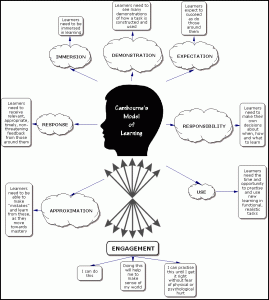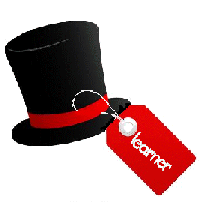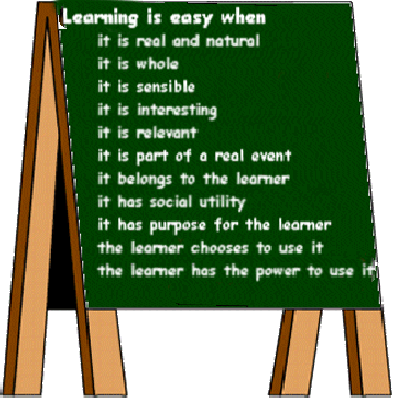The best parties are those where the guests mix and mingle, the conversation flows and ideas and information are shared, considered, discussed, perhaps even debated.
And so it has been at my party for over 40 years – I’ve had on my best party hat, circulated and participated, listened and learned, contemplated and celebrated. Now, I think I know enough to host a party with confidence and competence because this is what I know about the hat that the learner wears…
- The brain constantly grows and changes from conception to death.
- The brain develops over three decades with the sensory sectors being the most active in the first ten years, and those enabling deep and independent thinking developing over the second decade.
- Different ages have different needs and conditions for learning.
- We build new concepts on old understandings, and new information must be connected to a prior experience for it to make sense.
- Intelligence is not fixed – it is a combination of nature and nurture.
- An enriched environment with appropriate multi-sensory challenges and opportunities to explore it has a significant impact on learning.
- Boredom and threat diminish the brain as much as challenge enhances it.
- Learning is unique and is dependent on many factors, many of them internal and intrinsic to the individual.
- There are many ways to learn the same thing and we each have our own preferences and predilections to ensure success.
- There are two types of learning
- Experience-expectant which are the basic survival skills, including speech, which will occur in a well-described order and in a well-defined timeframe provided the child has the opportunities to learn them
- Experience-dependent learning of non-essential skills, including reading, which require explicit instruction, repetition, motivation and mental effort and which develop at different times and different rates for each individual.
So, I put on my teacher’s hat and I ask…
- How does this knowledge impact on what I know and believe about child development?
- How does this knowledge impact on what I know and believe about learning?
- How does this knowledge impact on what I know and believe about teaching?
- What is the driving force behind my current teaching programs and practices?
- How does that align with what I know and believe about learning?
- How does what I currently do and how I do it impact on the learning of my students?
- What sorts of teaching programs and practices are the most appropriate for what and how I want my students to learn at this time?
- What do my students need to know and be able to do five years from now as a result of my current programs and practices?
- What do I need to develop, change or abandon to provide my students with what they need, not what I think they should have?
- What sorts of environments should I be providing for my students?
- What can I do to guide my students along the path of lifelong learning?
Ken and Yetta Goodman say that learning is easy when…
- it is real and natural
- it is whole
- it is sensible
- it is interesting
- it is relevant
- it is part of a real event
- it belongs to the learner
- it has social utility
- it has purpose for the learner
- the learner chooses to use it
- the learner has the power to use it
So I have to consider…
- What knowledge, understandings, skills, attitudes, beliefs and values do I want my students to learn as a result of undertaking this task?
- How can I connect what I want them to know with what they already know?
- How can I demonstrate the purpose and relevance of this learning to their world?
- How can I determine that they have achieved what I intended?
Cambourne developed this model of learning…
Cambourne contends that successful learning is dependent on the learner…
- having a need to learn
- being physically and mentally capable of doing so
- being immersed in or surrounded by examples of what is to be learned
- receiving many demonstrations of what is to be learned and how it can be used
- expecting to succeed and knowing those around him expect success
- taking responsibility for what is learned, when and how it is learned
- having time and opportunities to practise and use their new skills in real-life situations
- being free to make mistakes and learn from these
- receiving relevant, timely, and non-threatening feedback from those who already know
Cambourne contends that the learner’s attitude to learning is critical and the most effective learning happens when the learner can make an emotional connection to what is being learned, and this is confirmed by Renate and Geoffrey Caine .
What we learn is influenced and organized by emotions and mindsets involving expectancy, personal biases and prejudices, self-esteem and the need for social interaction Emotions and thoughts literally shape each other and cannot be separated. Emotions color meaning … Moreover, the emotional impact of any lesson or life experience may continue to reverberate long after the specific event that triggers it. Hence an appropriate emotional climate is indispensable to sound education.
Caine R. and Caine G. 1994. Making connections: Teaching and the human brain.
Menlo Park,CA: Addison-Wesley
In a nutshell, I believe that it is essential that the learner perceives that the learning is necessary to make sense of the world and therefore has real purpose and meaning and is worth the effort and time involved.

Adapted from “The Whole Story: natural learning and the acquisition of literacy in the classroom” Cambourne, B. (1988)
So I ask …
- Do my students come to school each day in anticipation, not anxiety?
- Is their learning over before it starts because they have already shut down, telling themselves there is no purpose and denying themselves any chance of success?
- Do I unconsciously confirm those beliefs through my own attitudes and actions towards them?
- What can I do to promote more positive attitudes for both learner and teacher?
- What is the role of the library in providing a safe and satisfying learning environment?
- What is happening in the rest of the school that means the library is the only safe haven for some students?
- What sorts of options and opportunities can we offer to encourage, excite and extend student learning?



